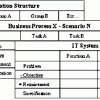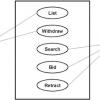The Latest
|
Four Keys to Better Test Management[article] There seemed to be a disjoint between development and test groups. There were four things that became very obvious to me, that were necessary to get better organized:
|
||
|
Software Test Script (template)[article] This Software Test Script template designed to keep track of automation status and revision history. It includes places to record issues, pre-conditions, and test steps. |
||
|
Software Configuration Management[magazine] Pat Wegerson recommends software configuration management resources AntiPatterns and Patterns in Software Configuration Management and the online CM Yellow Pages. |
||
|
How to Make Risk Conversations More Effective[article] Project managers may be reluctant, even unwilling, to discuss problems that testers discover in a project. In this column, management expert Johanna Rothman gives tips on how best to tell management that "the sky is falling," and how to respond if they don't want to hear about potential problems before they occur. |
||
|
Testing Applications for Pocket PC[article] Testing applications on Pocket PCs requires a special strategy and plan. It's different from testing normal client/server or Web-based application. Testing applications for Pocket PCs is like a mixture of strategies applied for testing client/server and Web-based applications. The test strategies applied for testing client/server applications like compatibility on different platforms, different hardware and software considerations, user interface and the strategies adopted for testing web applications like compatibility on different browsers (if it's a Web application for Pocket PC or PDA), security (authentication, authorization, data confidentiality) should be taken into consideration. Apart from the above, there are few more issues that we need to address while testing applications for Pocket PCs. |
||
|
Substituting Test Engineers with Development Engineers Is Ineffective[article] Many companies have recently decimated their software QA group during layoffs using the rationale that their software development engineers can be occasionally used when it is "time to test." This paper points out why this strategy is ineffective. |
Terry Horwath
May 20, 2002 |
|
|
Is Software Really Different?[article] Software is often seen as different from other products that seem more tangible and less flexible. In this article, Gerold Keefer points out that the perception of flexibility is not always a positive perception, and approaching software as a product that should be "done right the first time" can improve quality. Gerold also illustrates a number of tangible-product metaphors common in the software industry. |
Gerold Keefer
May 17, 2002 |
|
|
Thinking Games[article] Have you outgrown playing games, now that you're in the serious business of software quality assurance? Well, maybe it's time to get that old chess board out of the closet. In this column, Elisabeth Hendrickson argues that the thinking skills you develop from games will serve you well in planning software projects. |
||
|
Characteristics of a Software Testing Professional[article] This article is intended to throw some light on the characteristics or traits that a software testing professional should have to be a successful testing professional. |
Gayathri Chandrasekar
May 16, 2002 |
|
|
White Paper: Multi-Site Software Development [article] (MKS Product Whitepaper) There are unique challenges associated with enabling teams in multiple geographic locations to collaborate on the same software projects. A common myth is that replication is the answer. To this end, MKS introduces a new and innovative solution called the Federated Server Architecture (FSA). The FSA, developed by MKS, uses advanced and reliable caching technology while building on the widespread advancements in network availability and reliability. The result is a solution that has numerous advantages over the outdated replication paradigm, including lower total cost of ownership, reduced administrative burden, and access to real-time project information. Read this paper to learn more about the FSA and how MKS supports multi-site development. |
||
 |
A Systematic Approach for More Effective Communication of Functional Requirements and Specifications[article] The communication of functional requirements and specifications is the most difficult, critical, and error-prone task in IT projects. Research has shown that projects that proceed to the construction and coding phase with missing or wrong functional requirements and specifications are almost certain to fail. To avoid missing or misunderstanding the requirements for a solution, and to avoid the development of systems to incorrect specifications, we need a systematic approach to capturing, organizing, and validating the functional requirements and specifications. In this article, Bill Walton offers such an approach. |
Bill Walton
May 10, 2002 |
 |
Use Cases and Testing[article] This article introduces you to the most important diagrams used in object-oriented development and describes the UML notation used for these diagrams. It also provides practical questions you can ask to evaluate the quality of these object-oriented diagrams: Three sets of questions (complete, correct, and consistent) under three areas of testing (syntax testing, domain expert testing, and traceability testing). |
|
|
Manage the Risks and the Process[article] Including a testing/QA component early in a software project necessarily prolongs the schedule, right? Not so, according to Ross Collard. In this, the third of a three-part series, Collard explains how to anticipate risks and to aggressively manage the process to prevent disaster. |
||
|
From Waterfall to Iterative Development[article] In this article, the author describes some of the challenges of iterative development from the perspective of the project manager and discusses the common "traps" and pitfalls. |
Philippe Kruchten
May 7, 2002 |
|
|
The Four Quadrants of Techno-Management[article] During my career in software engineering spanning almost two decades across half a dozen organizations, I see a pattern. The organizations can be classified into four categories based on their strengths and weaknesses in management and technical capabilities. In today's business environment of speedy change and uncertainties, if the initiatives are not managed well, they can boomerang as an organizational energy waster. |








